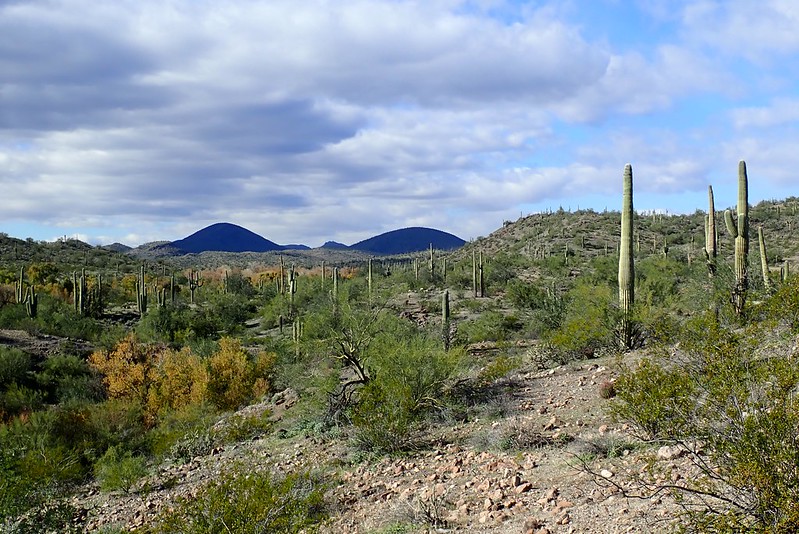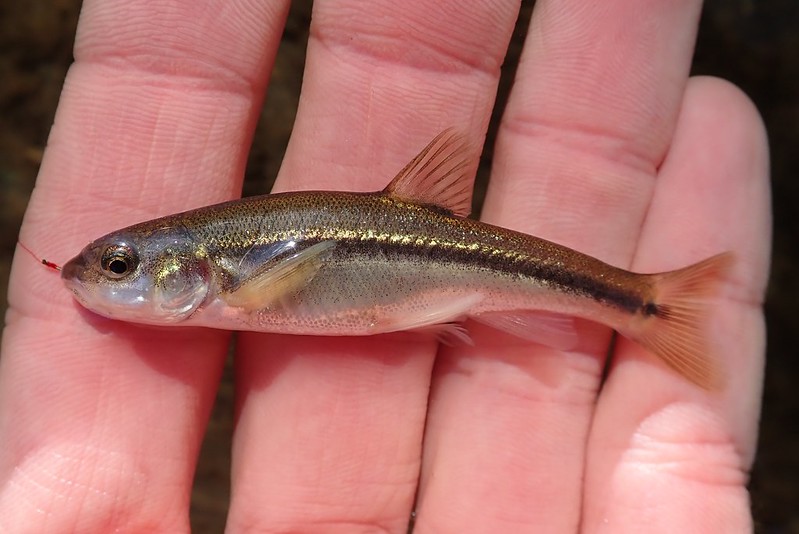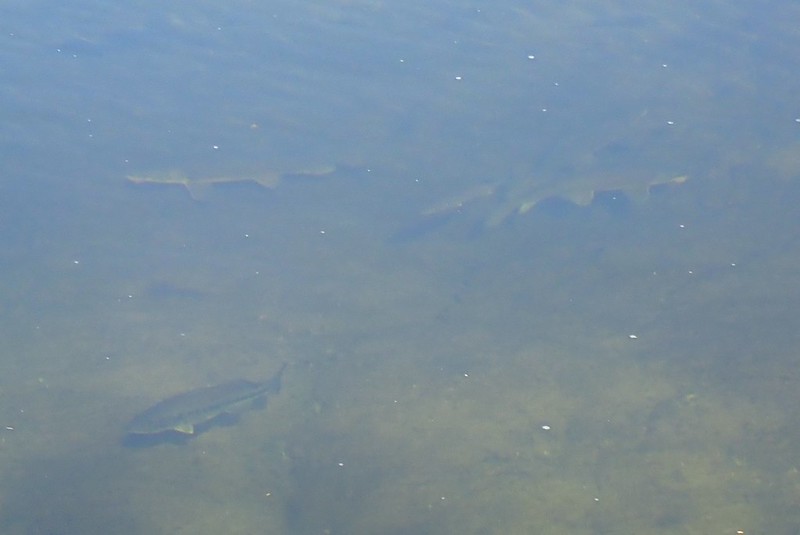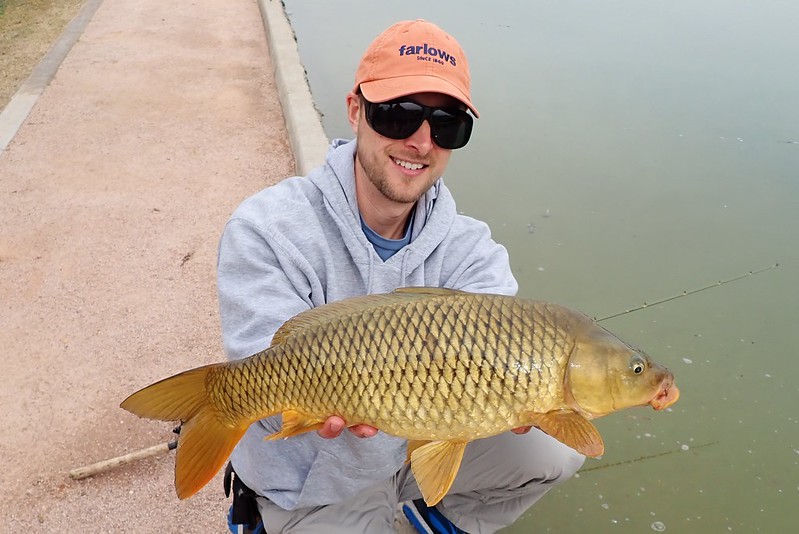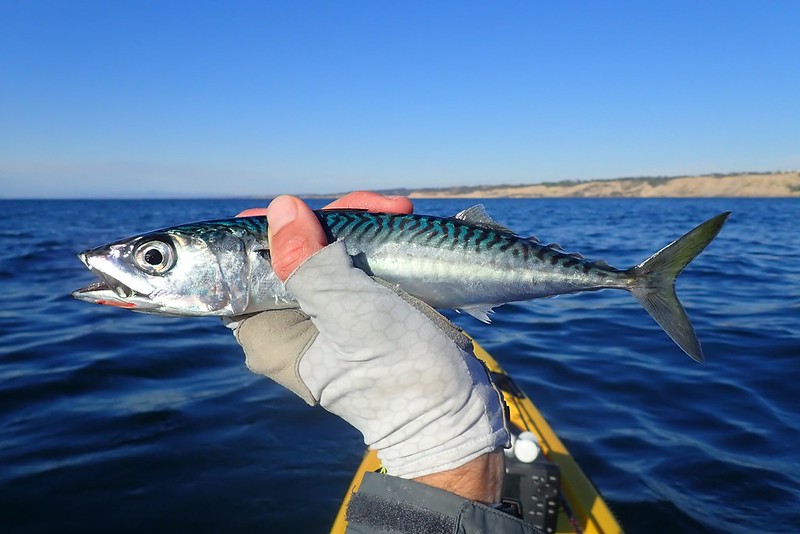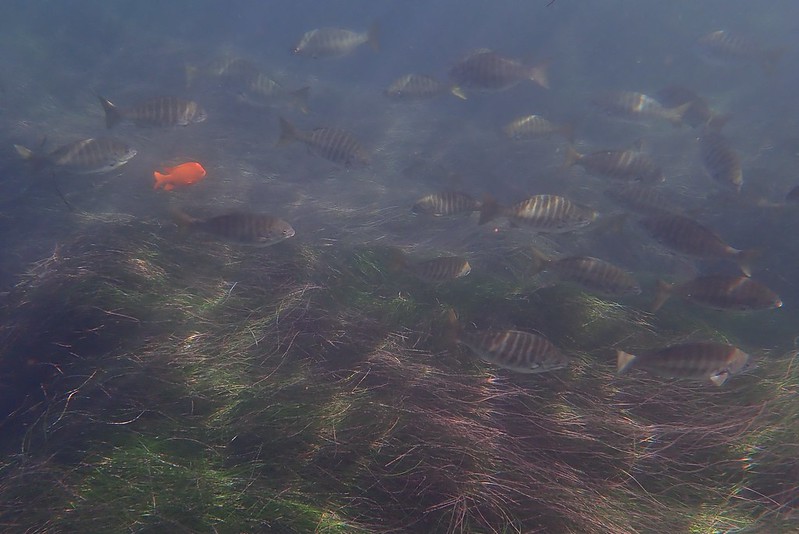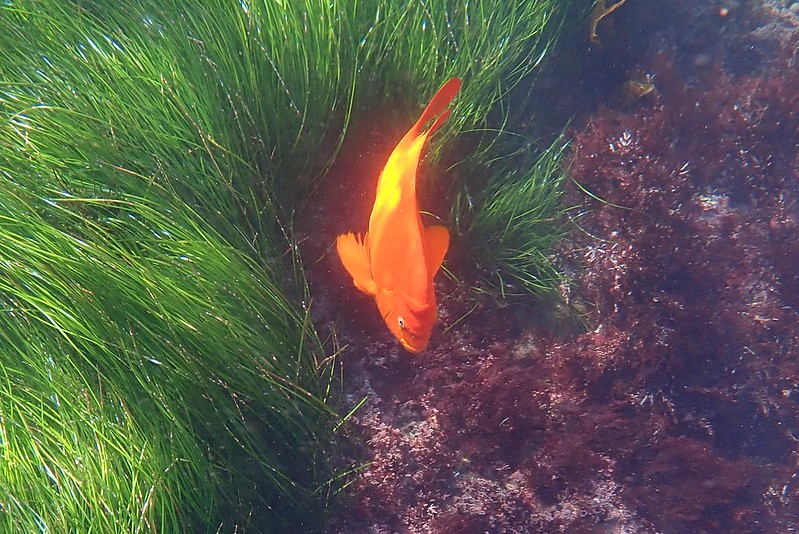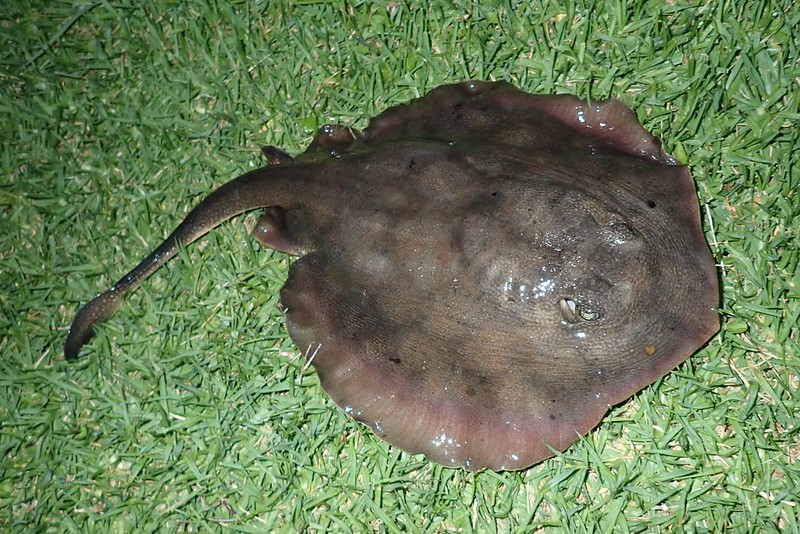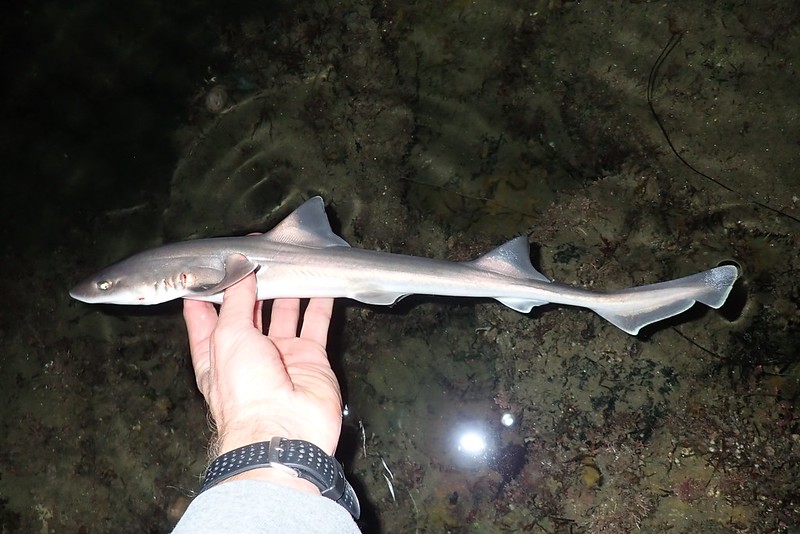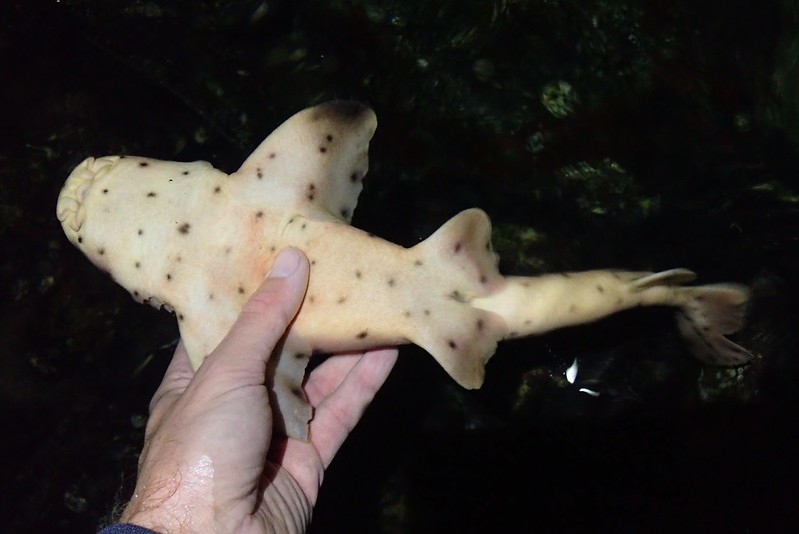Between Christmas and New Years I had a few extra days, so I drove over to Phoenix to do some winter fishing with my friend Chris and his boys. It had been colder than usual in Arizona, which would likely make the fishing tough, but Chris promised I could at least add longfin dace to my list, and that was good enough for me.
I arrived Saturday afternoon, transferred my microfishing gear to Chris's truck, and we drove over to a nearby stream to fish for dace. It was a 15 minute hike from the parking lot, which was a good thing, because you should have to work a little bit for new species.
Desert streams always seem to defy their surroundings, and this one was no exception. Once we scrambled down the small canyon to the creek, it was easy to forget that we were in the middle of the desert.
The stream was loaded with dace. They appeared equally at home in the deep slow pools and the swifter runs with undercut banks. I found a group of larger individuals, put a piece of aquatic insect on my hook, and pulled up a good looking male.
Longfin Dace (Agosia chrysogaster) - new hook & line species #652
I caught a few others that were larger, but none had a lateral stripe as distinct as the first one. At the time I assumed some of the chunkier fish were females, but looking through my photos it seems they all have traces of tubercles on their heads, so I guess that makes them all males.
A few of the longfin dace had fully developed tubercles, which meant they would be spawning soon. We also saw juvenile fish from the previous spawn.
The next morning I headed out before sunrise to spend the day on the Salt River. I had caught a Sonora sucker at this spot back in 2014, but I was looking forward to getting an updated photo of one in better light. More importantly, I hoped to have a shot at a desert sucker, which are more difficult to catch than Sonoras because they feed predominantly on algae. When I arrived at the river my car's thermometer said 27 deg. Would the fish be biting?
I spent the first few hours at the same spot I fished back in 2014. The angle of the morning light made it impossible to see into the pool, but I figured there must be suckers hanging out in the deepest part. I swapped out my bait (half a nightcrawler) every 15 minutes or so, but no one was interested.
Eventually I gave up and packed up to try somewhere further upstream. As I was crossing the riffle, I spotted a small fish tucked in the strands of algae. It didn't look like something that wanted to eat, so I scooped it up with my hand. It was a sailfin molly, and it looked like it was probably not going to survive the cold.
Sailfin Molly (Poecilia latipinna)
The sun was now higher in the sky, and I was able to see clearly into the pool at the second spot. I wasn't surprised to see dozens of suckers. Most looked to be Sonoras, but a few looked more grey in color and might have been deserts.
Unfortunately, being able to see the fish didn't help me catch one. I was able to cast past a large sucker perched on the slab rock and slowly reeled in until my half a nightcrawler was brushing gently against the front of its lip. Even then, they showed no interest in eating. There were largemouth bass and common carp cruising around as well, and they also showed zero interest.
On the third day we tried to salvage the trip by having me catch a Nile tilapia or a koi. The tilapia, if it looked convincingly like a pure Nile, would be a new species, but the koi would just be a novelty for my list of angling accomplishments, since it's the same species as common carp. We looked for Nile tilapia in a body of water that's fed by a wastewater discharge and empties into the Gila River,.
The low temperatures were still affecting the fishing, but eventually we each catch a few tilapia. The dorsal and anal fin shapes (rounded at the back) and tail markings (broken and wavy bars) suggested blue tilapia. They were likely hybrids, but they certainly couldn't be called Niles.
Blue Tilapia (Oreochromis aureus)
We also saw half a dozen large plecos hanging out on the concrete embankment. Plecos are a warm water species, so it wasn't surprising that they showed no interest in eating. Even in the warmer months they're an extremely challenging species to catch, but next time I'm in town I'd like to give it a shot.
I needed to head back to San Diego soon, but we had time for one more spot, a series of urban ponds stocked with koi and common carp. We walked up to one of the lakes to find a big school of roughly twenty koi swimming about. I tossed a couple of handfuls of canned corn, and within a minute or two they were feeding. I cast a small hook baited with a few kernels of corn into the mix, and within seconds I had a fish on. Was it a bright orange koi? Nope, it was one of the few common carp!
Common Carp (Cyprinus carpio)
The school of koi scattered during the fight with the carp, so we had to move spots and start a new feed going. It took an hour or two, but eventually I had a couple of the bright orange koi feeding again. I cast out, waited a few minutes, and then once again had a nice fish on the end of the line. And it was... drum roll please... another common carp!
I'll admit this road trip wasn't the most productive in terms of new species, but it did get me excited for my next trip to Arizona this spring or summer when it's warmer. I want to try for the two native species of trout - Gila and Apache - and pick up any other natives along the way. Urban fishing in Phoenix should be able to produce a pure Nile tilapia (Chris has good info on them being stocked), plus the abundant inland silversides in Tempe Town Lake. And for good measure I really would like one of those bright orange koi!
Saturday, December 28, 2019
Tuesday, December 24, 2019
San Francisco road trip with very little fishing
We decided not to fly anywhere for the holidays this year. Instead, we road tripped up to San Franciso to visit Steve and Marta. Steve has been telling me for years how seriously they take Christmas, and needless to say we weren't disappointed. If you're unfamiliar with Steve Wozniak, be sure to check out his blog: (https://1000fish.wordpress.com/). For some reason, I appear in a lot of his stories holding a cat. You'll have to ask Steve why that is.
On the drive up we stopped in Santa Clarita to check out a spot for convict cichlid I found on iNaturalist. Lifelist fishing will take you to some interesting locations, and this one happened to be a ditch behind a gas station.

The ditch fed into the Santa Clarita River, which is dry most of the year. So where does this water come from you ask? If you guessed sewage effluent from the nearby waste water treatment plant, you are correct.

The research for this spot paid off, because there were hundreds of convict cichlids here! Armed with a gas station turkey sandwich for bait, I got out my Tenkara gear. Catching a cichlid was no problem, but it took a little bit of time to find one with nice markings for a good lifelist photo.
Convict Cichlid (Amatitlania nigrofasciata) - new hook & line species #650

I was hoping to find a few more exotic releases here, but the only other fish I saw were mosquitofish. The iridescent green and purple made me wonder if it might be something else, but the rows of black spots on the tail are characteristic of mosquitofish.
Western Mosquitofish (Gambusia affinis)

Before left I stuck my camera in the sewage effluent to get some underwater photos of the cichlids. This one should give you a sense of just how many there were. (I washed my camera afterward.)

Up in the bay area we split our time between hanging out with Steve and Marta and seeing a few of the sights. Mostly we just looked at this big red bridge.

As we wandered along the coast we found a sign for a local fish, but it was one that could not be caught. No swimming, wading, or microfishing allowed in the lagoon.

The next day we said our farewells and headed south. We stopped in Monterey and walked around the Cannery Row part of town. John Steinbeck is one of my favorite authors, and this quote seemed fitting for the tidepools we planned to visit in the afternoon.
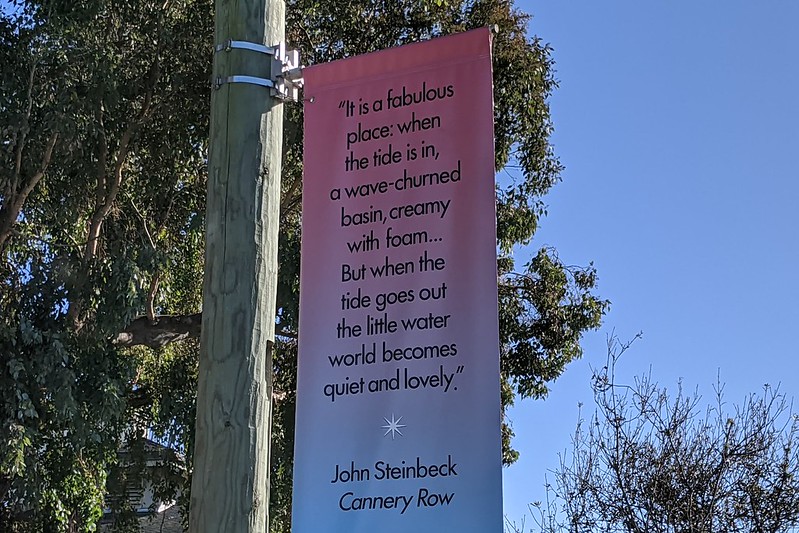
After lunch we drove through Pebble Beach and stopped at a tidepooling spot right in time for low tide. We couldn't stay long, but it looked promising!

The tidepools here were full of life - snails, crabs, sea stars, octopodes, and of course, fish. The color theme for the vegetation in the pools was dark maroon and light pink.
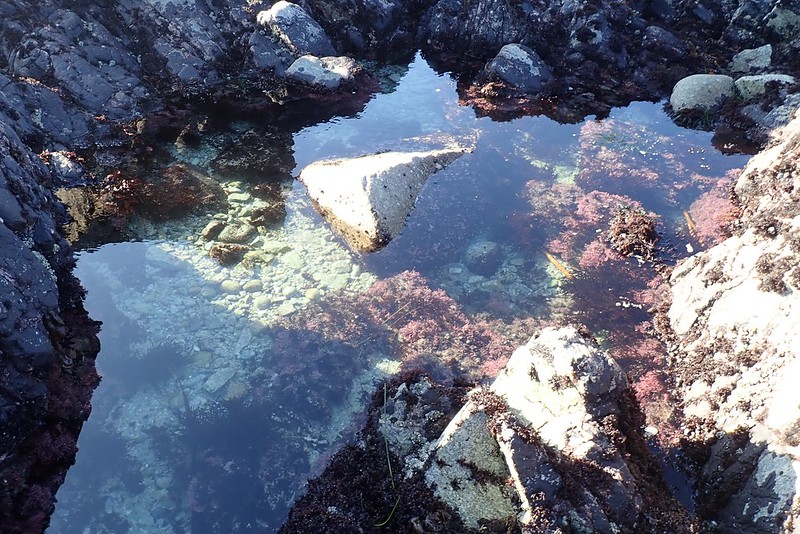
My hope was that I could find something besides woolly and tidepool sculpin. I wasn't sure what species would be most common at this spot, but I had a sinking feeling it would be tidepool sculpin, which is what I caught in northern California a year and a half ago. However, when I keyed them out back at home, I found they were rosy sculpin, a new one!
Rosy Sculpin (Oligocottus rubellio) - new hook & line species #651
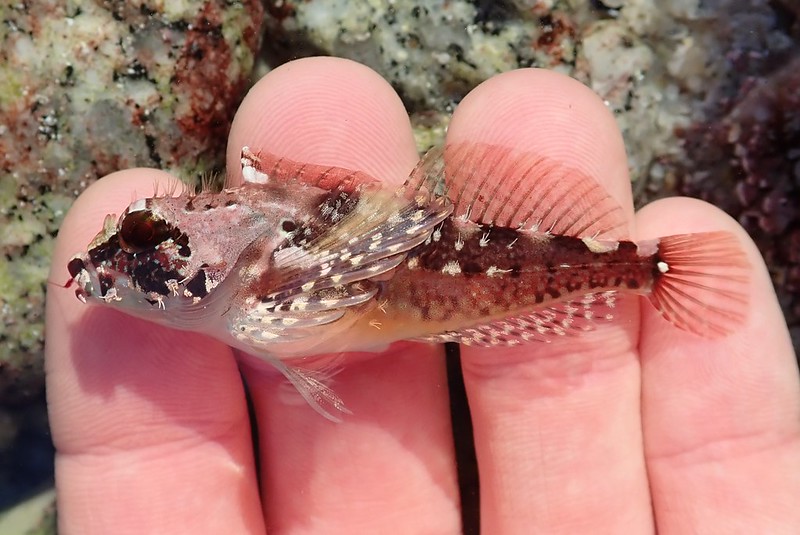
View of the rosy sculpin top.

And view of the rosy sculpin bottom.
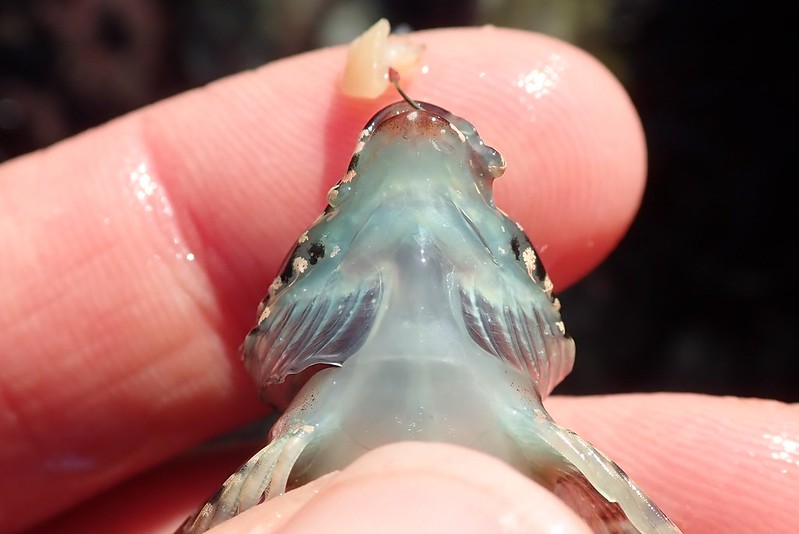
The sculpins all looked to be the same species, so I focused my last 15 minutes on trying to catch a clingfish or pricleback. Finding them was no problem, but getting them to bite was. Finally, when I ran out of time, I picked up a clingfish so I could at least get a picture.
Northern Clingfish (Gobiesox maeandricus)

I've always thought that line that looks like a big frown was the clingfish's mouth, but I learned something new when I held up this one. The real mouth is actually below it! It's hard to unsee that frowny face though, haha.

We wanted to leave the tidepools in time to see the view at Big Sur, and we made it just in time. We crossed the iconic bridge along California 1 and parked at one of the pull-offs to watch the sunset.

There's a lot of Californian coast between San Diego and San Francisco, and someday I'd really like to explore it more with time to figure out the local fishing along the way. Hopefully I'll be back soon!
On the drive up we stopped in Santa Clarita to check out a spot for convict cichlid I found on iNaturalist. Lifelist fishing will take you to some interesting locations, and this one happened to be a ditch behind a gas station.

The ditch fed into the Santa Clarita River, which is dry most of the year. So where does this water come from you ask? If you guessed sewage effluent from the nearby waste water treatment plant, you are correct.

The research for this spot paid off, because there were hundreds of convict cichlids here! Armed with a gas station turkey sandwich for bait, I got out my Tenkara gear. Catching a cichlid was no problem, but it took a little bit of time to find one with nice markings for a good lifelist photo.
Convict Cichlid (Amatitlania nigrofasciata) - new hook & line species #650

I was hoping to find a few more exotic releases here, but the only other fish I saw were mosquitofish. The iridescent green and purple made me wonder if it might be something else, but the rows of black spots on the tail are characteristic of mosquitofish.
Western Mosquitofish (Gambusia affinis)

Before left I stuck my camera in the sewage effluent to get some underwater photos of the cichlids. This one should give you a sense of just how many there were. (I washed my camera afterward.)

Up in the bay area we split our time between hanging out with Steve and Marta and seeing a few of the sights. Mostly we just looked at this big red bridge.

As we wandered along the coast we found a sign for a local fish, but it was one that could not be caught. No swimming, wading, or microfishing allowed in the lagoon.

The next day we said our farewells and headed south. We stopped in Monterey and walked around the Cannery Row part of town. John Steinbeck is one of my favorite authors, and this quote seemed fitting for the tidepools we planned to visit in the afternoon.

After lunch we drove through Pebble Beach and stopped at a tidepooling spot right in time for low tide. We couldn't stay long, but it looked promising!

The tidepools here were full of life - snails, crabs, sea stars, octopodes, and of course, fish. The color theme for the vegetation in the pools was dark maroon and light pink.

My hope was that I could find something besides woolly and tidepool sculpin. I wasn't sure what species would be most common at this spot, but I had a sinking feeling it would be tidepool sculpin, which is what I caught in northern California a year and a half ago. However, when I keyed them out back at home, I found they were rosy sculpin, a new one!
Rosy Sculpin (Oligocottus rubellio) - new hook & line species #651

View of the rosy sculpin top.

And view of the rosy sculpin bottom.

The sculpins all looked to be the same species, so I focused my last 15 minutes on trying to catch a clingfish or pricleback. Finding them was no problem, but getting them to bite was. Finally, when I ran out of time, I picked up a clingfish so I could at least get a picture.
Northern Clingfish (Gobiesox maeandricus)

I've always thought that line that looks like a big frown was the clingfish's mouth, but I learned something new when I held up this one. The real mouth is actually below it! It's hard to unsee that frowny face though, haha.

We wanted to leave the tidepools in time to see the view at Big Sur, and we made it just in time. We crossed the iconic bridge along California 1 and parked at one of the pull-offs to watch the sunset.

There's a lot of Californian coast between San Diego and San Francisco, and someday I'd really like to explore it more with time to figure out the local fishing along the way. Hopefully I'll be back soon!
Wednesday, December 18, 2019
Deep dropping 1500 feet from the kayak
The surf and wind forecast for Wednesday looked too good to pass up, so I used my last vacation day of the year to go kayaking in La Jolla. Launching on a weekday is great, because you pretty much have the beach and parking spots all to yourself.
The night before I plotted out GPS locations along the center of La Jolla Canyon, with the deepest one at 1500 feet. The wind typically picks up around 11am, so I planned to fish the deepest spot first and then work my way back towards shore. What did I expect to find at 1500 feet? Honestly I wasn't sure, but I hoped to pull up a weird species like hake, eelpout, cusk-eel, or one of the many species of flatfish that prefers deeper water.
Unsurprisingly, the fish finder had trouble with depths more than about 550 feet. It didn't register the bottom at 1500 feet, but when I moved up the canyon to the next spot it briefly picked up 1325 feet, and I took a quick photo. If you look closely, you can see the bottom on the contour plot, but there was no way to see structure or fish hanging out at the bottom.
Dropping to the bottom in 1500 feet was no problem when there was no wind. I used a 28 oz torpedo sinker, 500 meters (1640 feet) of 65 lb braid main line, and a Penn Fathom 2-speed Lever Drag. My terminal tackle had four #4 circle hooks on 10 lb mono branch lines, so really not much bigger than a sabiki. I couldn't legally fish for rockfish because of the depth (and because of the four hooks), so I had a descending device ready to go in case I caught any off limits groundfish incidentally.
I swapped out fresh squid strips on every drop, but I didn't get a single bite. I also alternated between using and not using a deep drop strobe light. I know lights are important for catching large predators like grouper, but I wasn't sure if they'd attract the smaller less aggressive species that I was going for.
My one fish of the day was a mackerel that grabbed one of the baits in the top 30 feet of water.
Pacific Chub Mackerel (Scomber japonicus)
The wind picked up right on cue and put a stop to the fishing. The paddle back was kind of rough. I was coming back at a 30 degree angle to the waves, and the bigger waves would push my bow to the left, while the wind wanted to push my bow to the right. The wind was more of an issue, and I pretty much paddled the entire way back using only my right side. I think I'll have to invest in a rudder if I'm going to keep doing these long distance paddles. This was my longest paddle to date, and I felt it!
Miles: 12.70
Hours: 7:32
I try to keep my blog posts heavy on the fish content, so to make up for the lack of fish in the actual report, here's a few photos I took underwater with my camera on a non-fishing kayak trip in the La Jolla marine reserve a few weeks ago.
Zebra Chub (Kyphosus azureus)
Garibaldi (Hypsypops rubicundus)
Here are the stats for that trip.
Miles: 4.37
Hours: 3:00
And don't worry, I won't give up on deep dropping in La Jolla Canyon! Those weird fish are down there, so it's just a matter of finding them. One of my redeeming qualities is stubbornness, so I'll keep trying until I figure it out.
Safety Extra:
If you kayak in the ocean, make sure to practice capsizing and self rescuing! After paddling in the marine reserve I did three intentional capsizes before coming in to land. The water was surprisingly cold, and by the third re-entry I wanted nothing more than to be on land, dry, and warm. When I got home I ordered a pair of neoprene wetsuit bottoms to wear during the cold months.
The night before I plotted out GPS locations along the center of La Jolla Canyon, with the deepest one at 1500 feet. The wind typically picks up around 11am, so I planned to fish the deepest spot first and then work my way back towards shore. What did I expect to find at 1500 feet? Honestly I wasn't sure, but I hoped to pull up a weird species like hake, eelpout, cusk-eel, or one of the many species of flatfish that prefers deeper water.
Unsurprisingly, the fish finder had trouble with depths more than about 550 feet. It didn't register the bottom at 1500 feet, but when I moved up the canyon to the next spot it briefly picked up 1325 feet, and I took a quick photo. If you look closely, you can see the bottom on the contour plot, but there was no way to see structure or fish hanging out at the bottom.
Dropping to the bottom in 1500 feet was no problem when there was no wind. I used a 28 oz torpedo sinker, 500 meters (1640 feet) of 65 lb braid main line, and a Penn Fathom 2-speed Lever Drag. My terminal tackle had four #4 circle hooks on 10 lb mono branch lines, so really not much bigger than a sabiki. I couldn't legally fish for rockfish because of the depth (and because of the four hooks), so I had a descending device ready to go in case I caught any off limits groundfish incidentally.
I swapped out fresh squid strips on every drop, but I didn't get a single bite. I also alternated between using and not using a deep drop strobe light. I know lights are important for catching large predators like grouper, but I wasn't sure if they'd attract the smaller less aggressive species that I was going for.
My one fish of the day was a mackerel that grabbed one of the baits in the top 30 feet of water.
Pacific Chub Mackerel (Scomber japonicus)
The wind picked up right on cue and put a stop to the fishing. The paddle back was kind of rough. I was coming back at a 30 degree angle to the waves, and the bigger waves would push my bow to the left, while the wind wanted to push my bow to the right. The wind was more of an issue, and I pretty much paddled the entire way back using only my right side. I think I'll have to invest in a rudder if I'm going to keep doing these long distance paddles. This was my longest paddle to date, and I felt it!
Miles: 12.70
Hours: 7:32
I try to keep my blog posts heavy on the fish content, so to make up for the lack of fish in the actual report, here's a few photos I took underwater with my camera on a non-fishing kayak trip in the La Jolla marine reserve a few weeks ago.
Zebra Chub (Kyphosus azureus)
Garibaldi (Hypsypops rubicundus)
Here are the stats for that trip.
Miles: 4.37
Hours: 3:00
And don't worry, I won't give up on deep dropping in La Jolla Canyon! Those weird fish are down there, so it's just a matter of finding them. One of my redeeming qualities is stubbornness, so I'll keep trying until I figure it out.
Safety Extra:
If you kayak in the ocean, make sure to practice capsizing and self rescuing! After paddling in the marine reserve I did three intentional capsizes before coming in to land. The water was surprisingly cold, and by the third re-entry I wanted nothing more than to be on land, dry, and warm. When I got home I ordered a pair of neoprene wetsuit bottoms to wear during the cold months.
Thursday, December 12, 2019
And finally a San Diego horn shark!
Horn sharks are really cool fish, and they have eluded me. They're in San Diego Bay, Mission Bay, tucked in rocks and reefs offshore, and in the surf at night. They're everywhere around San Diego, but I haven't been able to find one to call my own. This year I made catching one a priority.
I started my earnest search for a horn shark in August when Steve was in town for a visit. We had a good location in Mission Bay from my friend Josh. In fact, I had fished with him there on several occasions, and nearly every time someone in the group caught a horn shark.

We got our baits out after sunset, casting far enough out to clear the eel grass beds. The rest of the night was a waiting game. I've become used to out-of-town visitors catching species that I still need - while standing right next to me - so I wasn't surprised when Steve pulled in a horn shark in the first 30 mins. I got a hit as well, but it was a small guitarfish.
Shovelnose Guitarfish (Rhinobatos productus)
After that it was bite after bite, but none materialized into a horn shark for me. Mostly it was smoothhounds and round rays, but a decent butterfly helped round out the catch.
Gray Smoothhound (Mustelus californicus)
Haller's Round Ray (Urobatis halleri)
California Butterfly Ray (Gymnura marmorata)
The night was getting late, and we were ready for that one last fish before calling it. Right on cue something bent my rod over hard. We assumed it would be a bat ray, the surf tractor of the sea, but when got it to shore we saw that it was a big diamond ray! I forgot all about horn sharks as we scrambled up the rocks to do a photo shoot. Afterward, Steve and I agreed that the night went well with him getting the shark and me getting the ray, since he already had the ray from a past trip to Mexico.
Diamond Stingray (Dasyatis dipterura) - new hook & line species #644
I managed to avoid thinking about horn sharks in September, but in October I was back at it again. The water was still warm from the summer, but it would be dropping soon. I'll admit that I started to become superstitious about the person next to me always catching the horn shark, so I went by myself to eliminate that possibility. It has been a while since I used the auto timer on my camera, so I took some practice shots. Just imagine a beautiful big horn shark in my hands!
It turned out to be an extremely slow night, with the only catches being a couple of smoothhounds and one extremely small guitarfish. It beat wearing the stripe, but it's too bad one of them couldn't have been a little horn shark instead.
Gray Smoothhound (Mustelus californicus)
Shovelnose Guitarfish (Rhinobatos productus)
This was the smallest guitarfish I've seen, and one thing that stuck out to me was the sharp scutes along it's back, similar to the "thorns" on a thornback. It makes sense that the juveniles need a little extra protection, but I wonder why they don't just keep them as adults. Guitarfish really don't have any defense other than their camouflage.
My next horn shark attempt was in November, and this time Josh and my running friend Ryan joined me. It was another slow night. We were definitely into fall, and the water temps were dropping. I caught a couple of round rays, and Josh caught a small diamond ray with two barbs on its tail. Can you guess what Ryan caught? That's right, a great big horn shark. Unfortunately it unhooked itself in the water as I was trying to grab it, so we didn't get a photo. It was a tough way to end the night.
Haller's Round Ray (Urobatis halleri)
Diamond Stingray (Dasyatis dipterura)
Finally it was December, my last chance of catching a horn shark in 2019. I invited two of the researchers I had recently met from Scripps, Jimjohn and Zach, to join me. Zach was interested in having a live horn shark to use in one of his research projects, but I think mostly the two of them came out to enjoy a nice evening outside. After all, my track record of catching horn sharks was pretty dismal.
This was the slowest night yet for this location. Not even the round rays or smoothhounds would show up. The hours ticked by, and I was feeling defeated. But then... my rod tip bounced a little, I felt something small on the other end, and I reeled in the fish I had been looking for, a San Diego horn shark. Mission accomplished.
Horn Shark (Heterodontus francisci) - new hook & line species #649
I was so happy about this catch that I took a photo of it from every angle. It was covered in cute little black spots, and you can see the horns at the base of it's two dorsal fins.
It's belly and fins were also covered in the same black spots. Adorable!
From above it's head looks like a little dinosaur. A really cute dinosaur.
But then things get weird when you take a look at it's mouth. It's like a cute little pig somehow crossed with a cute little wood chipper.
I've run out of things to say about this fish, but here's a view of it's mouth from below. Pig crossed with wood chipper crossed with cute alien. It's impossible not to love it.
I held the shark in the water while Zach jogged back to his car to get his bucket and aerator. We were lucky it was such a small specimen, because a larger one probably wouldn't have fit. I packed up my fishing gear, and the little lady (it was a female horn shark) headed off to Scripps.
I've considered horn shark to be my nemesis for so long, now that I've caught one I'm not sure what should take it's place. Midshipman, cabezon, and staghorn sculpin come to mind. I'll have to give it some more thought and officially declare a nemesis for 2020. Stay tuned!
I started my earnest search for a horn shark in August when Steve was in town for a visit. We had a good location in Mission Bay from my friend Josh. In fact, I had fished with him there on several occasions, and nearly every time someone in the group caught a horn shark.

We got our baits out after sunset, casting far enough out to clear the eel grass beds. The rest of the night was a waiting game. I've become used to out-of-town visitors catching species that I still need - while standing right next to me - so I wasn't surprised when Steve pulled in a horn shark in the first 30 mins. I got a hit as well, but it was a small guitarfish.
Shovelnose Guitarfish (Rhinobatos productus)
After that it was bite after bite, but none materialized into a horn shark for me. Mostly it was smoothhounds and round rays, but a decent butterfly helped round out the catch.
Gray Smoothhound (Mustelus californicus)
Haller's Round Ray (Urobatis halleri)
California Butterfly Ray (Gymnura marmorata)
The night was getting late, and we were ready for that one last fish before calling it. Right on cue something bent my rod over hard. We assumed it would be a bat ray, the surf tractor of the sea, but when got it to shore we saw that it was a big diamond ray! I forgot all about horn sharks as we scrambled up the rocks to do a photo shoot. Afterward, Steve and I agreed that the night went well with him getting the shark and me getting the ray, since he already had the ray from a past trip to Mexico.
Diamond Stingray (Dasyatis dipterura) - new hook & line species #644
I managed to avoid thinking about horn sharks in September, but in October I was back at it again. The water was still warm from the summer, but it would be dropping soon. I'll admit that I started to become superstitious about the person next to me always catching the horn shark, so I went by myself to eliminate that possibility. It has been a while since I used the auto timer on my camera, so I took some practice shots. Just imagine a beautiful big horn shark in my hands!
It turned out to be an extremely slow night, with the only catches being a couple of smoothhounds and one extremely small guitarfish. It beat wearing the stripe, but it's too bad one of them couldn't have been a little horn shark instead.
Gray Smoothhound (Mustelus californicus)
Shovelnose Guitarfish (Rhinobatos productus)
This was the smallest guitarfish I've seen, and one thing that stuck out to me was the sharp scutes along it's back, similar to the "thorns" on a thornback. It makes sense that the juveniles need a little extra protection, but I wonder why they don't just keep them as adults. Guitarfish really don't have any defense other than their camouflage.
My next horn shark attempt was in November, and this time Josh and my running friend Ryan joined me. It was another slow night. We were definitely into fall, and the water temps were dropping. I caught a couple of round rays, and Josh caught a small diamond ray with two barbs on its tail. Can you guess what Ryan caught? That's right, a great big horn shark. Unfortunately it unhooked itself in the water as I was trying to grab it, so we didn't get a photo. It was a tough way to end the night.
Haller's Round Ray (Urobatis halleri)
Diamond Stingray (Dasyatis dipterura)
Finally it was December, my last chance of catching a horn shark in 2019. I invited two of the researchers I had recently met from Scripps, Jimjohn and Zach, to join me. Zach was interested in having a live horn shark to use in one of his research projects, but I think mostly the two of them came out to enjoy a nice evening outside. After all, my track record of catching horn sharks was pretty dismal.
This was the slowest night yet for this location. Not even the round rays or smoothhounds would show up. The hours ticked by, and I was feeling defeated. But then... my rod tip bounced a little, I felt something small on the other end, and I reeled in the fish I had been looking for, a San Diego horn shark. Mission accomplished.
Horn Shark (Heterodontus francisci) - new hook & line species #649
I was so happy about this catch that I took a photo of it from every angle. It was covered in cute little black spots, and you can see the horns at the base of it's two dorsal fins.
It's belly and fins were also covered in the same black spots. Adorable!
From above it's head looks like a little dinosaur. A really cute dinosaur.
But then things get weird when you take a look at it's mouth. It's like a cute little pig somehow crossed with a cute little wood chipper.
I've run out of things to say about this fish, but here's a view of it's mouth from below. Pig crossed with wood chipper crossed with cute alien. It's impossible not to love it.
I held the shark in the water while Zach jogged back to his car to get his bucket and aerator. We were lucky it was such a small specimen, because a larger one probably wouldn't have fit. I packed up my fishing gear, and the little lady (it was a female horn shark) headed off to Scripps.
I've considered horn shark to be my nemesis for so long, now that I've caught one I'm not sure what should take it's place. Midshipman, cabezon, and staghorn sculpin come to mind. I'll have to give it some more thought and officially declare a nemesis for 2020. Stay tuned!
Subscribe to:
Comments (Atom)
